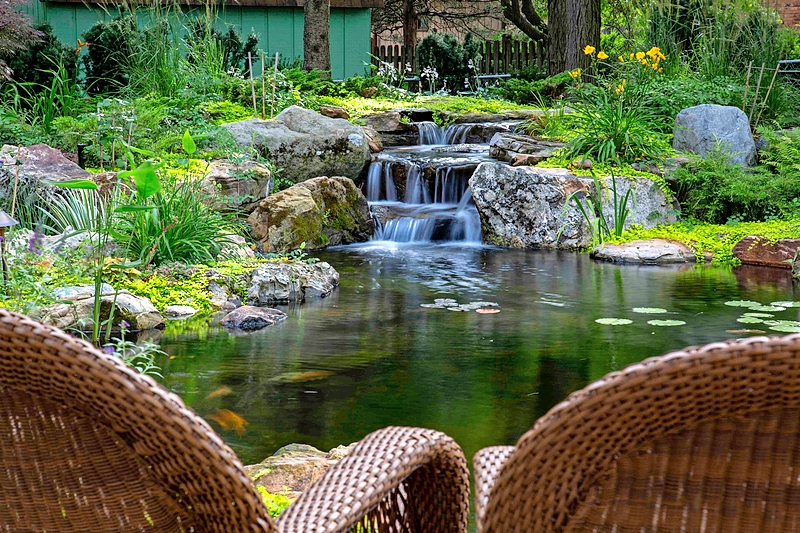Water Works
By Naperville Magazine
Appears in the June 2023 issue.
By Mark Loehrke
Building a backyard pond—for your family and the local flora and fauna

Even as outdoor fireplaces, kitchens, and viewing rooms have become staples of upscale home landscape design in recent years, the backyard pond hasn’t always been invited to the patio party. Whether due to anticipated maintenance hassles (brought on, in many cases, by past experience with an imploring child and a neglected bedroom aquarium) or perceived costs, ponds aren’t as popular as other backyard amenities.
But that tide may be starting to turn, according to Brian Helfrich, vice president of construction at St. Charles–based Aquascape, which installs anywhere from 50 to 75 residential ponds throughout the Chicago area every year. And he says it’s not hard to see why ponds are on something of an upward trend.
“A pond changes the lifestyle of the homeowner,” Helfrich explains. “They’ll be drawn outside to spend more time by the pond, enjoying the sound of running water and watching the fish, as well as the birds, butterflies, dragonflies, frogs, and toads that are drawn to the area. And kids love to play in the water and explore nature—things they can do right in their own backyard with a pond.”
What does it take to bring this little slice of nature into one’s backyard? Here are a few of Helfrich’s prime pond pointers:

Cost Considerations
Pond size is the biggest determinant of cost—the larger the pond, the more labor, rocks, and features it will require. Those looking to keep the budget down may want to consider a smaller layout, although Helfrich says most pond owners he hears from wish they had made theirs bigger—while the empty hole tends to look large after excavation, the pond seems smaller when hardscaped (rocks take up more space than you may think). Installed ponds generally start at around $12,000, while DIY pond kits can be had for as little as $1,500 or less. “Many homeowners have installed their own ponds with great success,” Helfrich notes, adding that Aquascape has a step-by-step video playlist to help DIYers. “Kits make the job easier because all the components are included, taking the guesswork out of deciding what type of pump, plumbing, and filtration are needed. The hardest part of a DIY pond is digging the hole and placing the rocks.”
Favored Features
Helfrich says a key feature of most residential ponds is a waterfall, which not only helps to aerate and circulate the water but also provides soothing sounds and ambience to the yard. Fish fans, meanwhile, will want to consider a feeding rock—a large, flat rock upon which to sit and dangle one’s feet in the water while feeding fish—among the pond’s variety of boulders. “The fish will become accustomed to being fed in the same spot and will swim up to greet you at the feeding rock,” he says.

Maintenance Misconceptions
Addressing one of the big concerns among the pond-curious, Helfrich says that a properly installed pond will require minimal ongoing upkeep, with occasional water treatments and skimmer basket cleanings constituting the main tasks, in addition to seasonal chores like winterizing and spring clean-outs. “You’ll have more maintenance mowing and maintaining a lawn than you will a pond,” he notes. “And the pond will actually take up yard space that you’d otherwise have to mow and weed anyway.”
Photos: Aquascape Inc.


